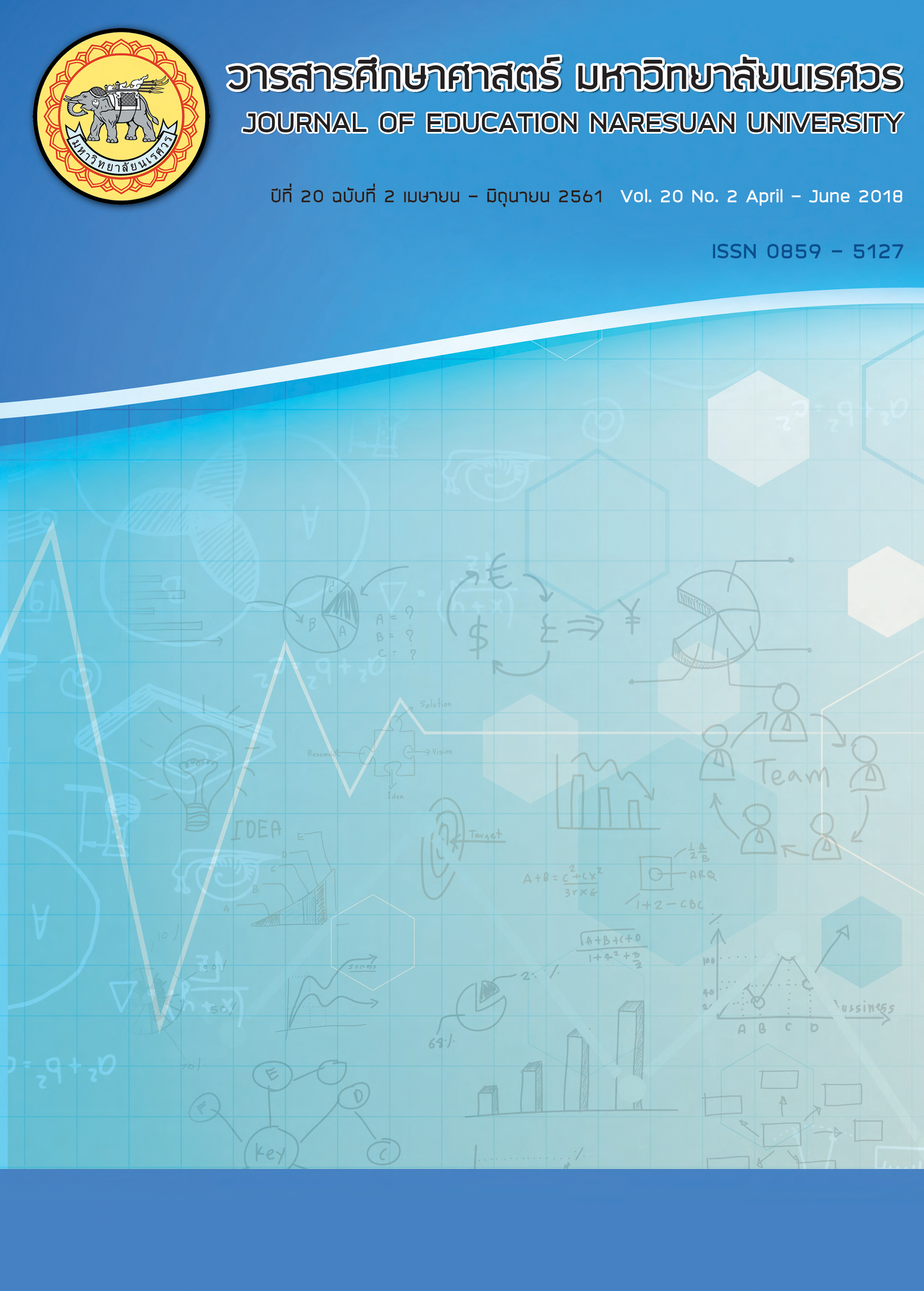การพัฒนากิจกรรมฝึกออกเสียงวรรณยุกต์ภาษาจีน ตามแนวคิดพหุสัมผัส สำหรับนักเรียนชั้นมัธยมศึกษาปีที่ 1; THE DEVELOPMENT OF ACTIVITY IN PRONUNCIATION OF MANDARIN TONES BASED ON SOMATICALLY-ENHANCED APPROACH FOR GRADE SEVEN STUDENTS
Main Article Content
Abstract
การวิจัยครั้งนี้มีจุดมุ่งหมายเพื่อ 1) สร้างและหาประสิทธิภาพของกิจกรรมฝึกออกเสียงวรรณยุกต์ภาษาจีนตามแนวคิดพหุสัมผัส สำหรับนักเรียนชั้นมัธยมศึกษาปีที่ 1 ให้มีประสิทธิภาพตามเกณฑ์ 75/75 2) เปรียบเทียบความสามารถในการออกเสียงวรรณยุกต์ภาษาจีนก่อนและหลังเรียนด้วยกิจกรรมฝึกออกเสียงวรรณยุกต์ภาษาจีนตามแนวคิดพหุสัมผัส และ 3) เพื่อศึกษาความพึงพอใจของนักเรียนที่มีต่อการเรียนด้วยกิจกรรมการฝึกออกเสียงวรรณยุกต์ภาษาจีนตามแนวคิดพหุสัมผัส กลุ่มตัวอย่างในงานวิจัยครั้งนี้คือ นักเรียนชั้นมัธยมศึกษาปีที่ 1 ภาคเรียนที่ 2 ปีการศึกษา 2558 โรงเรียนอุตรดิตถ์ จำนวน 40 คน ซึ่งได้มาโดยการสุ่มแบบเจาะจง เครื่องมือการวิจัยประกอบด้วย 1) กิจกรรมฝึกออกเสียงวรรณยุกต์ภาษาจีนตามแนวคิดพหุสัมผัส 2) แบบทดสอบความสามารถในการออกเสียงวรรณยุกต์ภาษาจีน และ 3) แบบสอบถาม ความพึงพอใจที่มีต่อกิจกรรมฝึกออกเสียงวรรณยุกต์ภาษาจีน สถิติที่ใช้ในการวิเคราะห์ข้อมูล ได้แก่ ค่าประสิทธิภาพ E1/E2 การทดสอบค่าที ค่าเฉลี่ย และค่าส่วนเบี่ยงเบนมาตรฐาน ผลการวิจัย พบว่า 1) กิจกรรมฝึกออกเสียงวรรณยุกต์ภาษาจีนตามแนวคิดพหุสัมผัสสำหรับนักเรียนชั้นมัธยมศึกษาปีที่ 1 มี 8 กิจกรรม ได้แก่ (1) การผ่อนคลาย (2) การออกเสียงในลำคอ (3) การปรบมือตามจังหวะของประโยค (4) การเคลื่อนไหวประกอบการแสดงท่าทาง (5) การออกเสียงเป็นคำ (6) การผันเสียงตามผู้สอน (7) การผันเสียงด้วยตนเอง และ (8) การตรวจสอบความหมาย ซึ่งกิจกรรมดังกล่าวมีประสิทธิภาพ 75.83/77.76, 77.50/78.33 และ 78.50/80.88 เป็นไปตามเกณฑ์ 75/75 2) นักเรียนที่ฝึกด้วยกิจกรรมฝึกออกเสียงวรรณยุกต์ภาษาจีนตามแนวคิดพหุสัมผัส มีความสามารถในการออกเสียงวรรณยุกต์ภาษาจีนหลังฝึกด้วยกิจกรรมสูงกว่าก่อนฝึกด้วยกิจกรรมอย่างมีนัยสำคัญทางสถิติที่ระดับ .01 และ 3) นักเรียนมีความพึงพอใจต่อกิจกรรมฝึกออกเสียงวรรณยุกต์ภาษาจีนตามแนวคิดพหุสัมผัสในระดับมากที่สุด ( = 4.54, S.D. = 0.67)
THE DEVELOPMENT OF ACTIVITY IN PRONUNCIATION OF MANDARIN TONES BASED ON SOMATICALLY-ENHANCED APPROACH FOR GRADE SEVEN STUDENTS
The purposes of this research were 1) to develop and assess, according to the 75/75 criteria, the efficiency of an activity of pronunciation of Mandarin tones based on the somatically-enhanced approach for seventh grade students, 2) to compare their ability of pronunciation of Mandarin tones before and after learning with the activity, and 3) to investigate their satisfaction towards learning with this activity. The research sample were 40 seventh grade students from Uttaradit School in Muang district, Uttaradit province in the second semester of the academic year 2015. The participants were selected by purposive sampling. The research instruments were 1) the activity of pronunciation of Mandarin tones based on the somatically-enhanced approach for seventh grade students, 2) the test of the ability of pronunciation of Mandarin tones, and 3) the questionnaire of satisfaction towards learning with the activity. The statistics employed for data analysis were the E1/E2 efficiency index, t-test, mean, and standard deviation. This research has demonstrated that 1) there were 8 activities of the pronunciation of Mandarin tones based on the somatically-enhanced approach for seventh grade students i.e.;
(1) relaxation, (2) humming, (3) clapping to the rhythm of the sentences, (4) incorporation of movement and gesture, (5) pronouncing words, (6) inflecting tones directed by the teacher, (7) inflecting tones by themselves, and (8) checking word for meaning. The activity of the pronunciation of Mandarin tones reached the efficiency value at 75.83/77.76, 77.50/78.33 and 78.50/80.88 respectively, thus satisfactorily meeting the 75/75 criteria, 2) the students’ ability to pronounce Mandarin tones after learning with the activity was statistically significant at the level of .01, and 3) their satisfaction towards the activity of the pronunciation of Mandarin tones was at the highest level with at 4.54, and S.D. at 0.67.
Article Details
The owner of the article does not copy or violate any of its copyright. If any copyright infringement occurs or prosecution, in any case, the Editorial Board is not involved in all the rights to the owner of the article to be performed.
References
Chinakarapong, S. (2012). Teaching Chinese as a foreign language essentiality of phonological teaching. Journal of humanities faculty of humanities Naresuan University, 9(1), 1-8. (in Thai)
Felicia Zhen Zhang. (2006). The teaching of mandarin prosody: a somatically-enhanced approach for second language learners. (Doctoral dissertation, University of Canberra).
Tirataradol, Y. (2010). Development of a Chinese language instructional model based on self-efficacy theory and autonomous learning to enhance Chinese speaking ability of undergraduate students (Doctoral dissertation). Bangkok: Chulalongkorn University.
(in Thai)
Varalakkanakul, S. (2006). The problem of Chinese language learning in Thailand. Ramkhamhaeng University Journal Humanities Edition, 26(1), 179-184. (in Thai)


